Analyzing Financial Statements & Improving Business Report
VerifiedAdded on 2023/06/14
|12
|2756
|208
Report
AI Summary
This report provides a detailed analysis of financial management principles and their practical application in business. It discusses the importance of financial management for investors, companies, and employees, emphasizing the need for careful planning, organizing, and controlling of funds. The report explains financial statements, including income statements, balance sheets, profit and loss accounts, and cash flow statements, highlighting their use in assessing a company's financial position and performance. Through ratio analysis, it evaluates the profitability, liquidity, and efficiency of a sample organization, interpreting key metrics such as gross profit ratio, net profit ratio, asset turnover ratio, and current ratio. Furthermore, the report explores strategies for business improvement, focusing on enhancing financial performance through increased sales, customer satisfaction, and shareholder equity. This document is available on Desklib, a platform offering a wide range of study resources for students.

3005
Paraphrase This Document
Need a fresh take? Get an instant paraphrase of this document with our AI Paraphraser
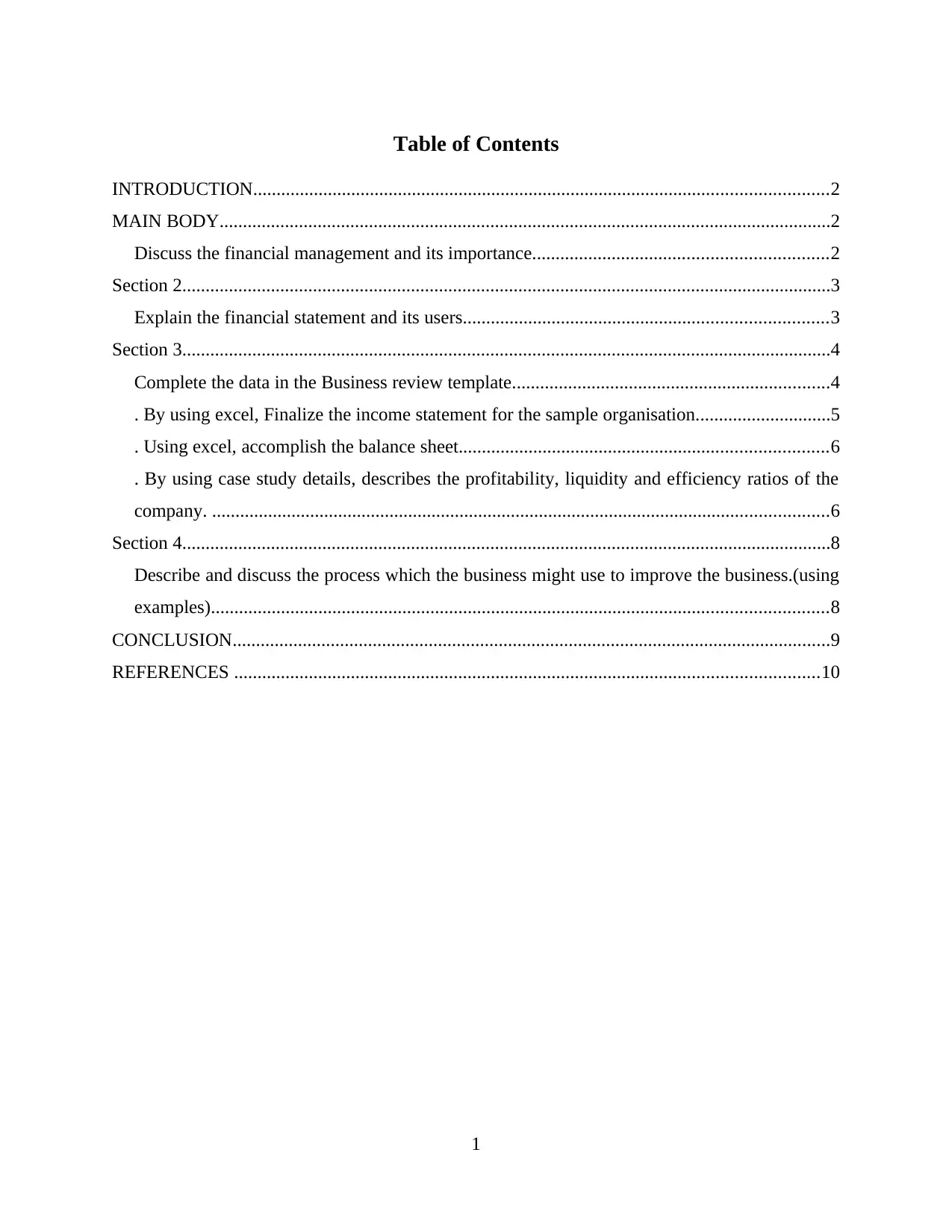
Table of Contents
INTRODUCTION...........................................................................................................................2
MAIN BODY...................................................................................................................................2
Discuss the financial management and its importance...............................................................2
Section 2...........................................................................................................................................3
Explain the financial statement and its users..............................................................................3
Section 3...........................................................................................................................................4
Complete the data in the Business review template....................................................................4
. By using excel, Finalize the income statement for the sample organisation.............................5
. Using excel, accomplish the balance sheet...............................................................................6
. By using case study details, describes the profitability, liquidity and efficiency ratios of the
company. ....................................................................................................................................6
Section 4...........................................................................................................................................8
Describe and discuss the process which the business might use to improve the business.(using
examples)....................................................................................................................................8
CONCLUSION................................................................................................................................9
REFERENCES .............................................................................................................................10
1
INTRODUCTION...........................................................................................................................2
MAIN BODY...................................................................................................................................2
Discuss the financial management and its importance...............................................................2
Section 2...........................................................................................................................................3
Explain the financial statement and its users..............................................................................3
Section 3...........................................................................................................................................4
Complete the data in the Business review template....................................................................4
. By using excel, Finalize the income statement for the sample organisation.............................5
. Using excel, accomplish the balance sheet...............................................................................6
. By using case study details, describes the profitability, liquidity and efficiency ratios of the
company. ....................................................................................................................................6
Section 4...........................................................................................................................................8
Describe and discuss the process which the business might use to improve the business.(using
examples)....................................................................................................................................8
CONCLUSION................................................................................................................................9
REFERENCES .............................................................................................................................10
1
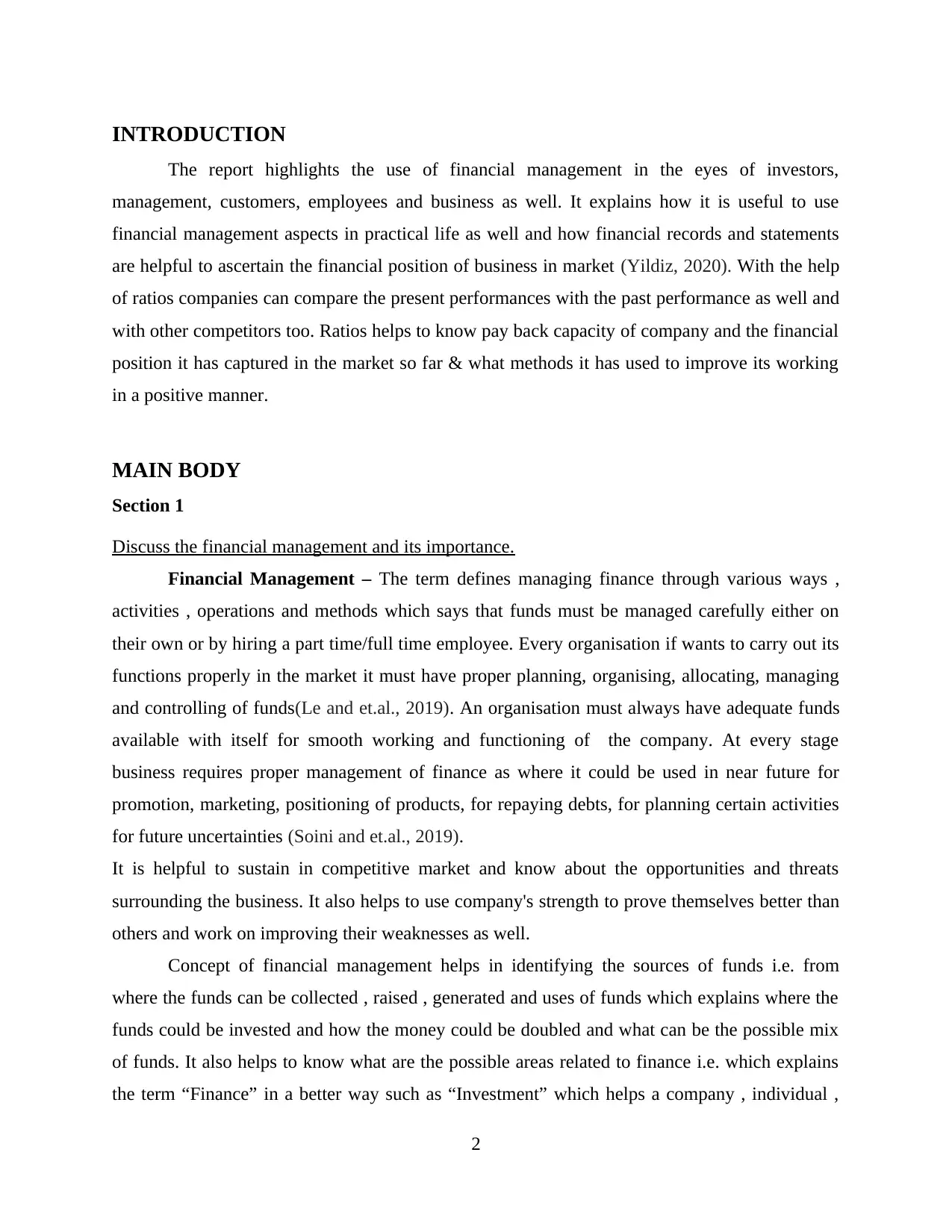
INTRODUCTION
The report highlights the use of financial management in the eyes of investors,
management, customers, employees and business as well. It explains how it is useful to use
financial management aspects in practical life as well and how financial records and statements
are helpful to ascertain the financial position of business in market (Yildiz, 2020). With the help
of ratios companies can compare the present performances with the past performance as well and
with other competitors too. Ratios helps to know pay back capacity of company and the financial
position it has captured in the market so far & what methods it has used to improve its working
in a positive manner.
MAIN BODY
Section 1
Discuss the financial management and its importance.
Financial Management – The term defines managing finance through various ways ,
activities , operations and methods which says that funds must be managed carefully either on
their own or by hiring a part time/full time employee. Every organisation if wants to carry out its
functions properly in the market it must have proper planning, organising, allocating, managing
and controlling of funds(Le and et.al., 2019). An organisation must always have adequate funds
available with itself for smooth working and functioning of the company. At every stage
business requires proper management of finance as where it could be used in near future for
promotion, marketing, positioning of products, for repaying debts, for planning certain activities
for future uncertainties (Soini and et.al., 2019).
It is helpful to sustain in competitive market and know about the opportunities and threats
surrounding the business. It also helps to use company's strength to prove themselves better than
others and work on improving their weaknesses as well.
Concept of financial management helps in identifying the sources of funds i.e. from
where the funds can be collected , raised , generated and uses of funds which explains where the
funds could be invested and how the money could be doubled and what can be the possible mix
of funds. It also helps to know what are the possible areas related to finance i.e. which explains
the term “Finance” in a better way such as “Investment” which helps a company , individual ,
2
The report highlights the use of financial management in the eyes of investors,
management, customers, employees and business as well. It explains how it is useful to use
financial management aspects in practical life as well and how financial records and statements
are helpful to ascertain the financial position of business in market (Yildiz, 2020). With the help
of ratios companies can compare the present performances with the past performance as well and
with other competitors too. Ratios helps to know pay back capacity of company and the financial
position it has captured in the market so far & what methods it has used to improve its working
in a positive manner.
MAIN BODY
Section 1
Discuss the financial management and its importance.
Financial Management – The term defines managing finance through various ways ,
activities , operations and methods which says that funds must be managed carefully either on
their own or by hiring a part time/full time employee. Every organisation if wants to carry out its
functions properly in the market it must have proper planning, organising, allocating, managing
and controlling of funds(Le and et.al., 2019). An organisation must always have adequate funds
available with itself for smooth working and functioning of the company. At every stage
business requires proper management of finance as where it could be used in near future for
promotion, marketing, positioning of products, for repaying debts, for planning certain activities
for future uncertainties (Soini and et.al., 2019).
It is helpful to sustain in competitive market and know about the opportunities and threats
surrounding the business. It also helps to use company's strength to prove themselves better than
others and work on improving their weaknesses as well.
Concept of financial management helps in identifying the sources of funds i.e. from
where the funds can be collected , raised , generated and uses of funds which explains where the
funds could be invested and how the money could be doubled and what can be the possible mix
of funds. It also helps to know what are the possible areas related to finance i.e. which explains
the term “Finance” in a better way such as “Investment” which helps a company , individual ,
2
⊘ This is a preview!⊘
Do you want full access?
Subscribe today to unlock all pages.

Trusted by 1+ million students worldwide
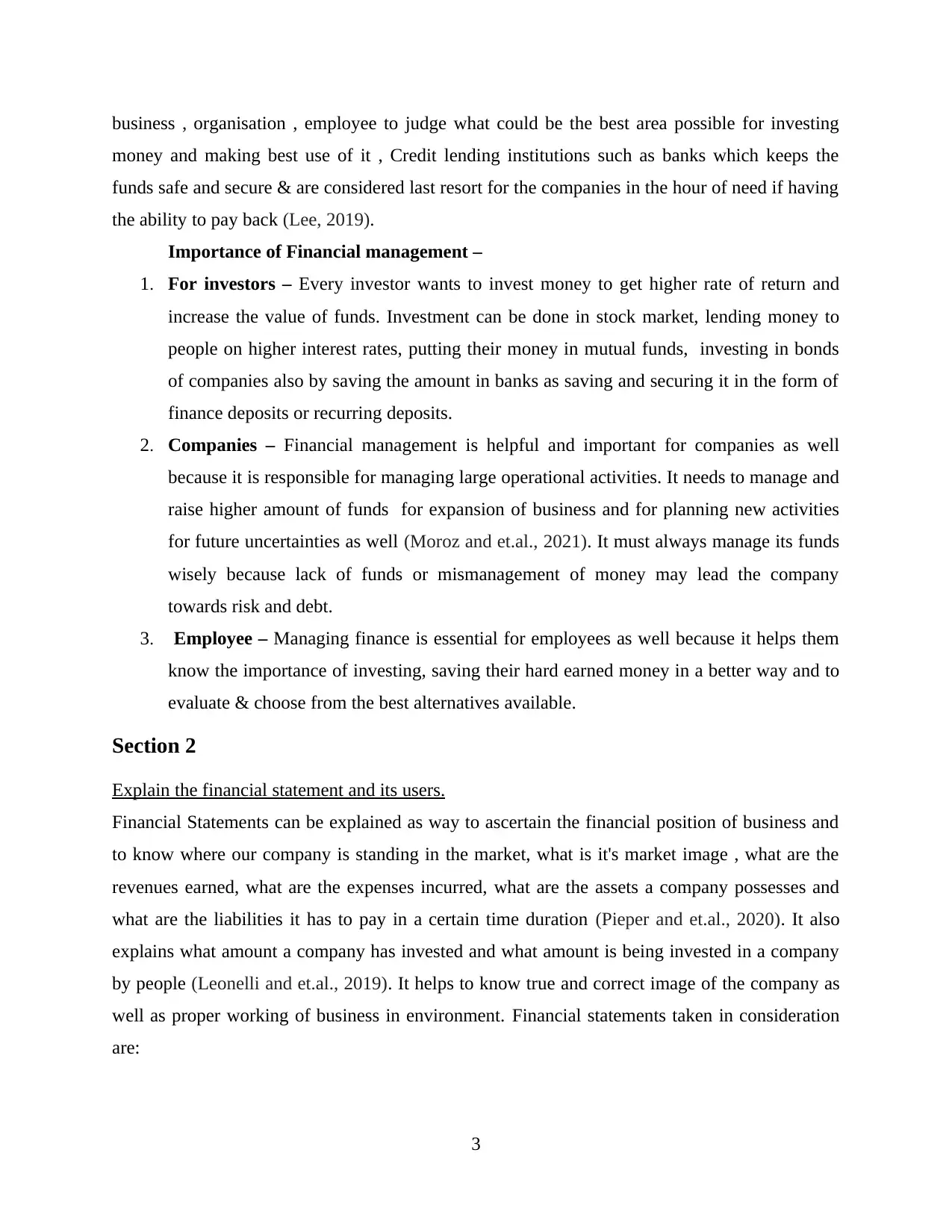
business , organisation , employee to judge what could be the best area possible for investing
money and making best use of it , Credit lending institutions such as banks which keeps the
funds safe and secure & are considered last resort for the companies in the hour of need if having
the ability to pay back (Lee, 2019).
Importance of Financial management –
1. For investors – Every investor wants to invest money to get higher rate of return and
increase the value of funds. Investment can be done in stock market, lending money to
people on higher interest rates, putting their money in mutual funds, investing in bonds
of companies also by saving the amount in banks as saving and securing it in the form of
finance deposits or recurring deposits.
2. Companies – Financial management is helpful and important for companies as well
because it is responsible for managing large operational activities. It needs to manage and
raise higher amount of funds for expansion of business and for planning new activities
for future uncertainties as well (Moroz and et.al., 2021). It must always manage its funds
wisely because lack of funds or mismanagement of money may lead the company
towards risk and debt.
3. Employee – Managing finance is essential for employees as well because it helps them
know the importance of investing, saving their hard earned money in a better way and to
evaluate & choose from the best alternatives available.
Section 2
Explain the financial statement and its users.
Financial Statements can be explained as way to ascertain the financial position of business and
to know where our company is standing in the market, what is it's market image , what are the
revenues earned, what are the expenses incurred, what are the assets a company possesses and
what are the liabilities it has to pay in a certain time duration (Pieper and et.al., 2020). It also
explains what amount a company has invested and what amount is being invested in a company
by people (Leonelli and et.al., 2019). It helps to know true and correct image of the company as
well as proper working of business in environment. Financial statements taken in consideration
are:
3
money and making best use of it , Credit lending institutions such as banks which keeps the
funds safe and secure & are considered last resort for the companies in the hour of need if having
the ability to pay back (Lee, 2019).
Importance of Financial management –
1. For investors – Every investor wants to invest money to get higher rate of return and
increase the value of funds. Investment can be done in stock market, lending money to
people on higher interest rates, putting their money in mutual funds, investing in bonds
of companies also by saving the amount in banks as saving and securing it in the form of
finance deposits or recurring deposits.
2. Companies – Financial management is helpful and important for companies as well
because it is responsible for managing large operational activities. It needs to manage and
raise higher amount of funds for expansion of business and for planning new activities
for future uncertainties as well (Moroz and et.al., 2021). It must always manage its funds
wisely because lack of funds or mismanagement of money may lead the company
towards risk and debt.
3. Employee – Managing finance is essential for employees as well because it helps them
know the importance of investing, saving their hard earned money in a better way and to
evaluate & choose from the best alternatives available.
Section 2
Explain the financial statement and its users.
Financial Statements can be explained as way to ascertain the financial position of business and
to know where our company is standing in the market, what is it's market image , what are the
revenues earned, what are the expenses incurred, what are the assets a company possesses and
what are the liabilities it has to pay in a certain time duration (Pieper and et.al., 2020). It also
explains what amount a company has invested and what amount is being invested in a company
by people (Leonelli and et.al., 2019). It helps to know true and correct image of the company as
well as proper working of business in environment. Financial statements taken in consideration
are:
3
Paraphrase This Document
Need a fresh take? Get an instant paraphrase of this document with our AI Paraphraser
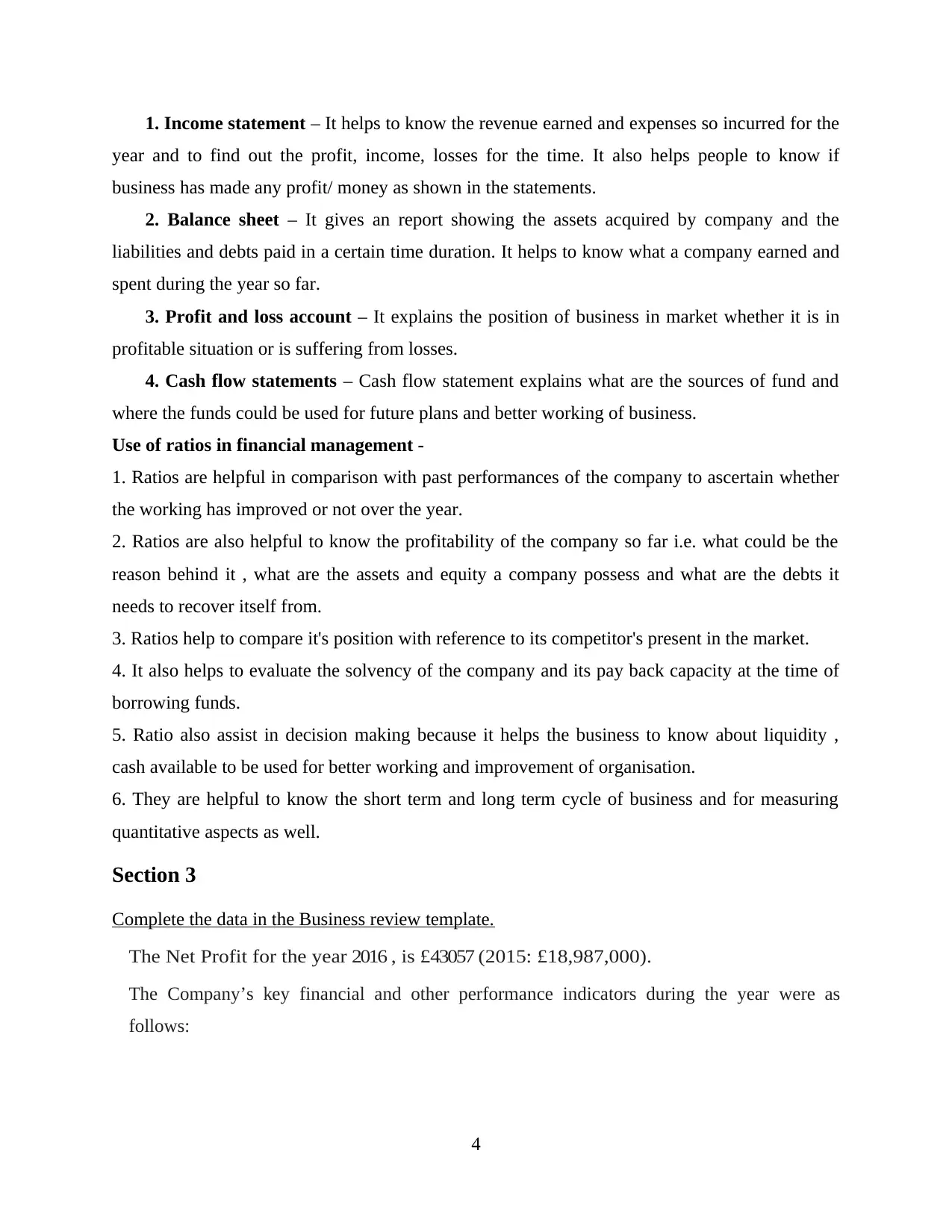
1. Income statement – It helps to know the revenue earned and expenses so incurred for the
year and to find out the profit, income, losses for the time. It also helps people to know if
business has made any profit/ money as shown in the statements.
2. Balance sheet – It gives an report showing the assets acquired by company and the
liabilities and debts paid in a certain time duration. It helps to know what a company earned and
spent during the year so far.
3. Profit and loss account – It explains the position of business in market whether it is in
profitable situation or is suffering from losses.
4. Cash flow statements – Cash flow statement explains what are the sources of fund and
where the funds could be used for future plans and better working of business.
Use of ratios in financial management -
1. Ratios are helpful in comparison with past performances of the company to ascertain whether
the working has improved or not over the year.
2. Ratios are also helpful to know the profitability of the company so far i.e. what could be the
reason behind it , what are the assets and equity a company possess and what are the debts it
needs to recover itself from.
3. Ratios help to compare it's position with reference to its competitor's present in the market.
4. It also helps to evaluate the solvency of the company and its pay back capacity at the time of
borrowing funds.
5. Ratio also assist in decision making because it helps the business to know about liquidity ,
cash available to be used for better working and improvement of organisation.
6. They are helpful to know the short term and long term cycle of business and for measuring
quantitative aspects as well.
Section 3
Complete the data in the Business review template.
The Net Profit for the year 2016 , is £43057 (2015: £18,987,000).
The Company’s key financial and other performance indicators during the year were as
follows:
4
year and to find out the profit, income, losses for the time. It also helps people to know if
business has made any profit/ money as shown in the statements.
2. Balance sheet – It gives an report showing the assets acquired by company and the
liabilities and debts paid in a certain time duration. It helps to know what a company earned and
spent during the year so far.
3. Profit and loss account – It explains the position of business in market whether it is in
profitable situation or is suffering from losses.
4. Cash flow statements – Cash flow statement explains what are the sources of fund and
where the funds could be used for future plans and better working of business.
Use of ratios in financial management -
1. Ratios are helpful in comparison with past performances of the company to ascertain whether
the working has improved or not over the year.
2. Ratios are also helpful to know the profitability of the company so far i.e. what could be the
reason behind it , what are the assets and equity a company possess and what are the debts it
needs to recover itself from.
3. Ratios help to compare it's position with reference to its competitor's present in the market.
4. It also helps to evaluate the solvency of the company and its pay back capacity at the time of
borrowing funds.
5. Ratio also assist in decision making because it helps the business to know about liquidity ,
cash available to be used for better working and improvement of organisation.
6. They are helpful to know the short term and long term cycle of business and for measuring
quantitative aspects as well.
Section 3
Complete the data in the Business review template.
The Net Profit for the year 2016 , is £43057 (2015: £18,987,000).
The Company’s key financial and other performance indicators during the year were as
follows:
4
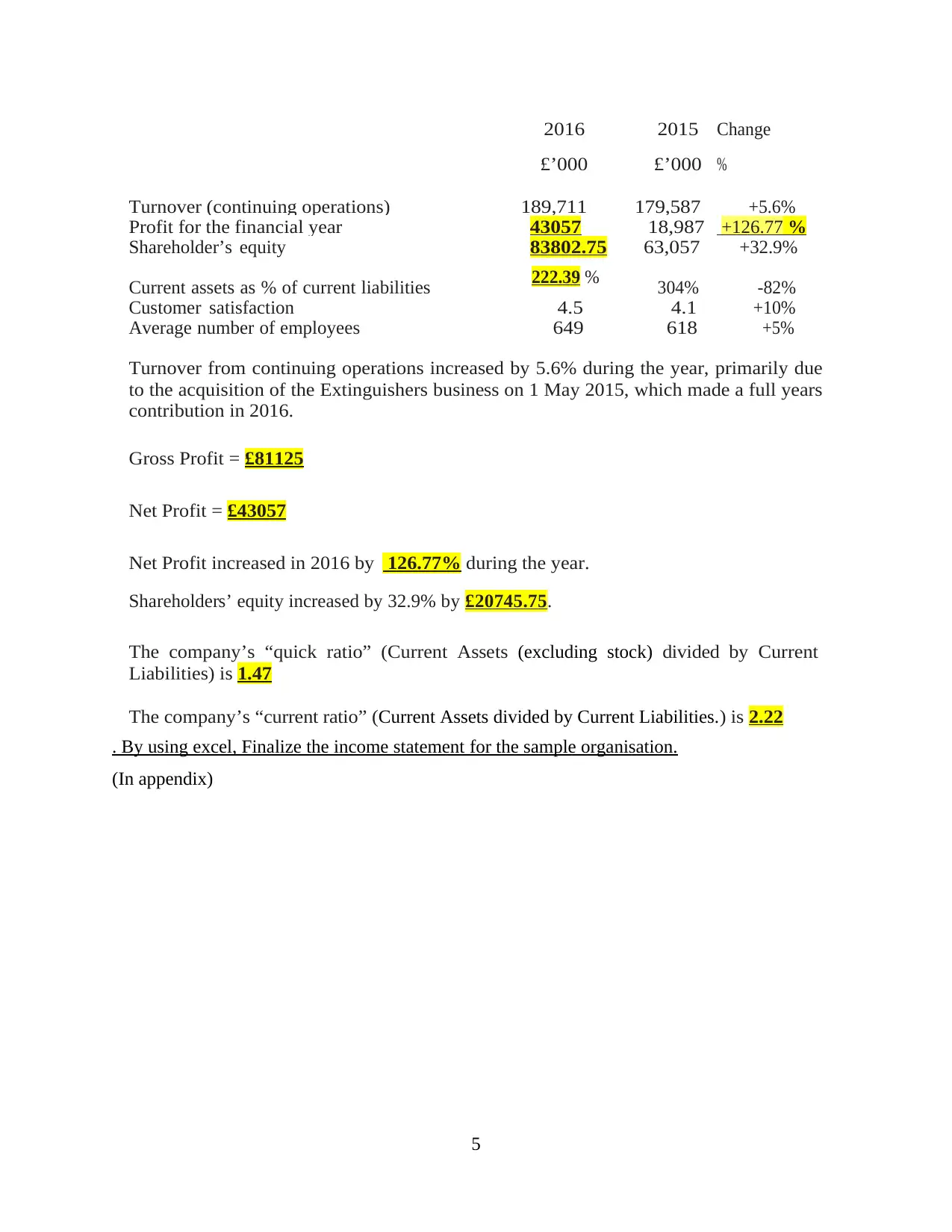
2016
£’000
2015
£’000
Change
%
Turnover (continuing operations) 189,711 179,587 +5.6%
Profit for the financial year 43057 18,987 +126.77 %
Shareholder’s equity 83802.75 63,057 +32.9%
Current assets as % of current liabilities 222.39 % 304% -82%
Customer satisfaction 4.5 4.1 +10%
Average number of employees 649 618 +5%
Turnover from continuing operations increased by 5.6% during the year, primarily due
to the acquisition of the Extinguishers business on 1 May 2015, which made a full years
contribution in 2016.
Gross Profit = £81125
Net Profit = £43057
Net Profit increased in 2016 by 126.77% during the year.
Shareholders’ equity increased by 32.9% by £20745.75.
The company’s “quick ratio” (Current Assets (excluding stock) divided by Current
Liabilities) is 1.47
The company’s “current ratio” (Current Assets divided by Current Liabilities. ) is 2.22
. By using excel, Finalize the income statement for the sample organisation.
(In appendix)
5
£’000
2015
£’000
Change
%
Turnover (continuing operations) 189,711 179,587 +5.6%
Profit for the financial year 43057 18,987 +126.77 %
Shareholder’s equity 83802.75 63,057 +32.9%
Current assets as % of current liabilities 222.39 % 304% -82%
Customer satisfaction 4.5 4.1 +10%
Average number of employees 649 618 +5%
Turnover from continuing operations increased by 5.6% during the year, primarily due
to the acquisition of the Extinguishers business on 1 May 2015, which made a full years
contribution in 2016.
Gross Profit = £81125
Net Profit = £43057
Net Profit increased in 2016 by 126.77% during the year.
Shareholders’ equity increased by 32.9% by £20745.75.
The company’s “quick ratio” (Current Assets (excluding stock) divided by Current
Liabilities) is 1.47
The company’s “current ratio” (Current Assets divided by Current Liabilities. ) is 2.22
. By using excel, Finalize the income statement for the sample organisation.
(In appendix)
5
⊘ This is a preview!⊘
Do you want full access?
Subscribe today to unlock all pages.

Trusted by 1+ million students worldwide
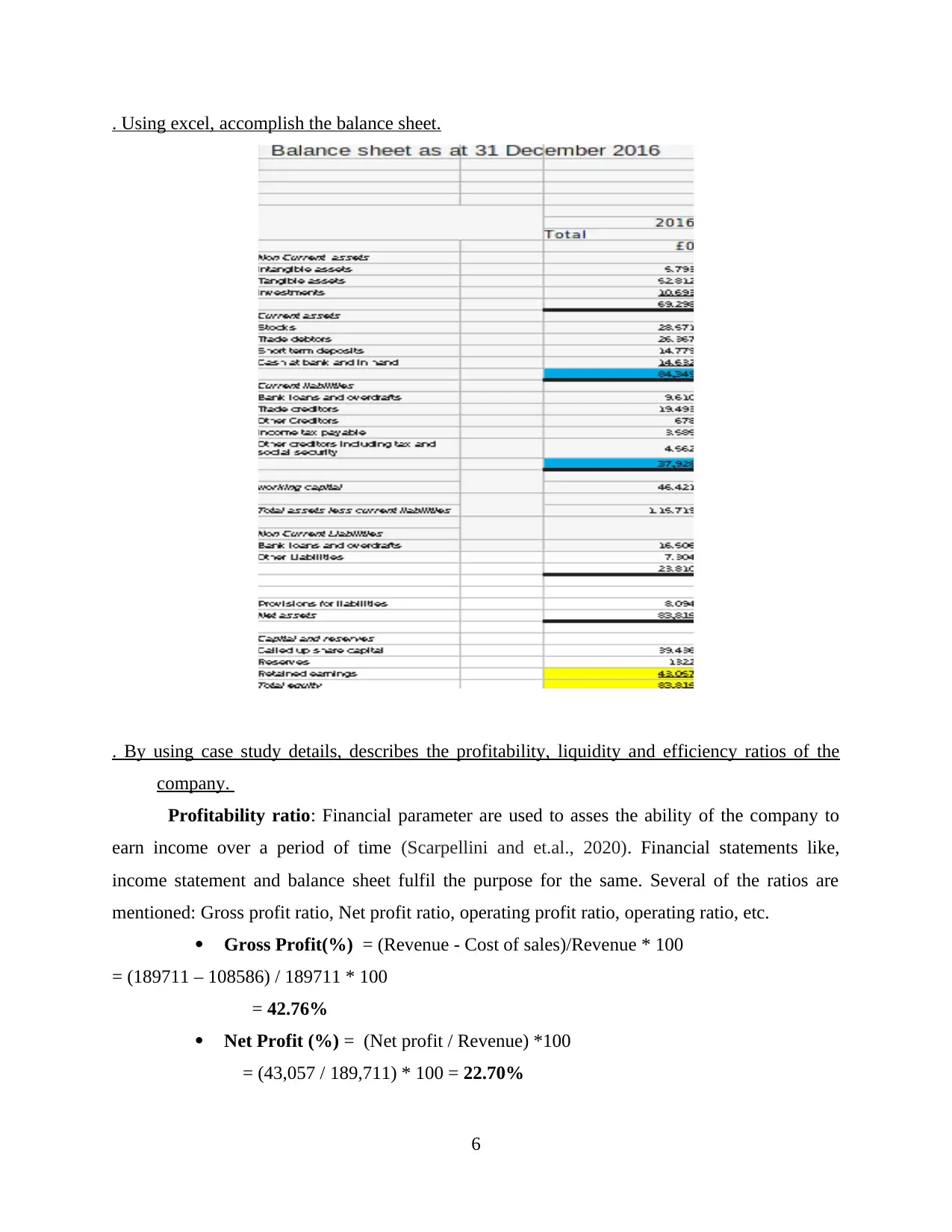
. Using excel, accomplish the balance sheet.
. By using case study details, describes the profitability, liquidity and efficiency ratios of the
company.
Profitability ratio: Financial parameter are used to asses the ability of the company to
earn income over a period of time (Scarpellini and et.al., 2020). Financial statements like,
income statement and balance sheet fulfil the purpose for the same. Several of the ratios are
mentioned: Gross profit ratio, Net profit ratio, operating profit ratio, operating ratio, etc.
Gross Profit(%) = (Revenue - Cost of sales)/Revenue * 100
= (189711 – 108586) / 189711 * 100
= 42.76%
Net Profit (%) = (Net profit / Revenue) *100
= (43,057 / 189,711) * 100 = 22.70%
6
. By using case study details, describes the profitability, liquidity and efficiency ratios of the
company.
Profitability ratio: Financial parameter are used to asses the ability of the company to
earn income over a period of time (Scarpellini and et.al., 2020). Financial statements like,
income statement and balance sheet fulfil the purpose for the same. Several of the ratios are
mentioned: Gross profit ratio, Net profit ratio, operating profit ratio, operating ratio, etc.
Gross Profit(%) = (Revenue - Cost of sales)/Revenue * 100
= (189711 – 108586) / 189711 * 100
= 42.76%
Net Profit (%) = (Net profit / Revenue) *100
= (43,057 / 189,711) * 100 = 22.70%
6
Paraphrase This Document
Need a fresh take? Get an instant paraphrase of this document with our AI Paraphraser
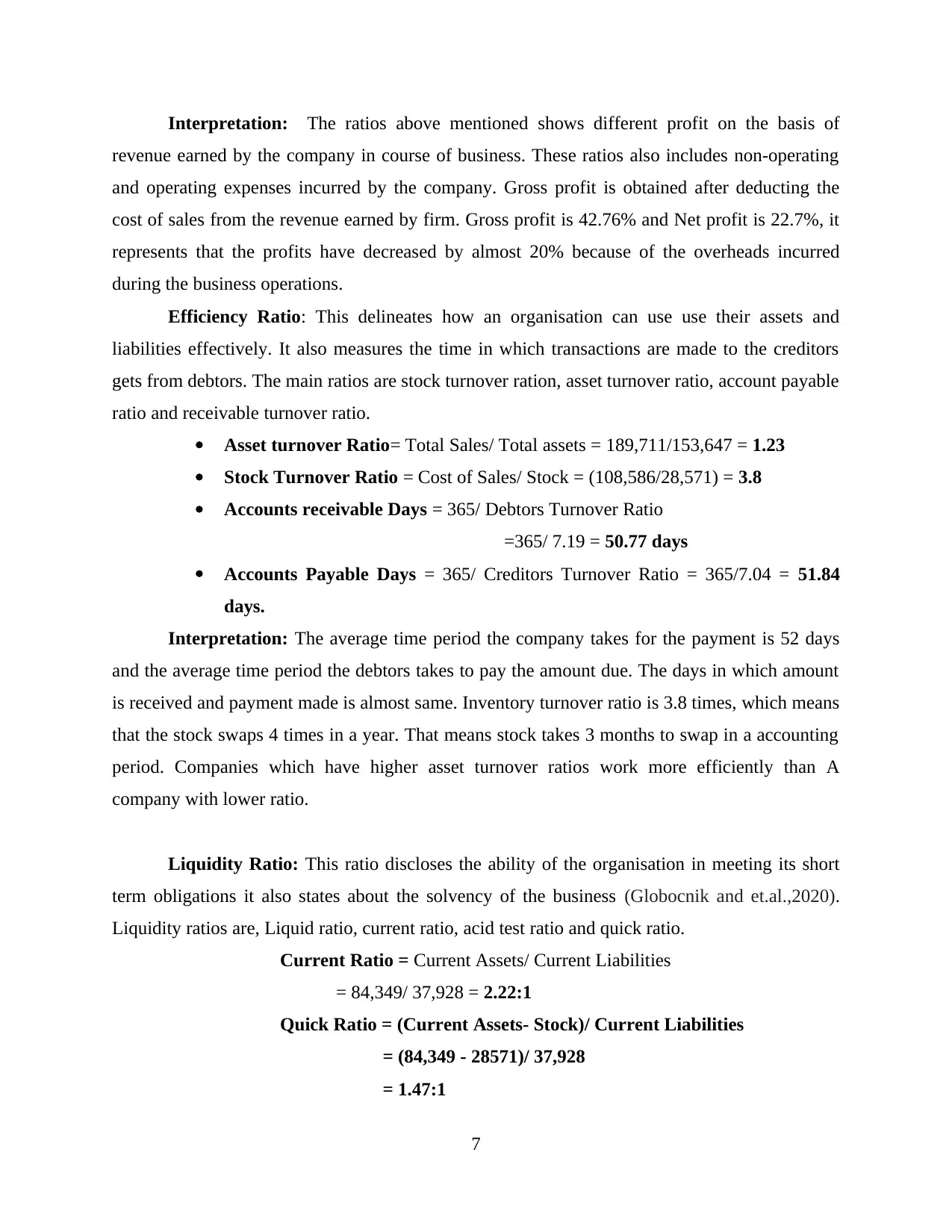
Interpretation: The ratios above mentioned shows different profit on the basis of
revenue earned by the company in course of business. These ratios also includes non-operating
and operating expenses incurred by the company. Gross profit is obtained after deducting the
cost of sales from the revenue earned by firm. Gross profit is 42.76% and Net profit is 22.7%, it
represents that the profits have decreased by almost 20% because of the overheads incurred
during the business operations.
Efficiency Ratio: This delineates how an organisation can use use their assets and
liabilities effectively. It also measures the time in which transactions are made to the creditors
gets from debtors. The main ratios are stock turnover ration, asset turnover ratio, account payable
ratio and receivable turnover ratio.
Asset turnover Ratio= Total Sales/ Total assets = 189,711/153,647 = 1.23
Stock Turnover Ratio = Cost of Sales/ Stock = (108,586/28,571) = 3.8
Accounts receivable Days = 365/ Debtors Turnover Ratio
=365/ 7.19 = 50.77 days
Accounts Payable Days = 365/ Creditors Turnover Ratio = 365/7.04 = 51.84
days.
Interpretation: The average time period the company takes for the payment is 52 days
and the average time period the debtors takes to pay the amount due. The days in which amount
is received and payment made is almost same. Inventory turnover ratio is 3.8 times, which means
that the stock swaps 4 times in a year. That means stock takes 3 months to swap in a accounting
period. Companies which have higher asset turnover ratios work more efficiently than A
company with lower ratio.
Liquidity Ratio: This ratio discloses the ability of the organisation in meeting its short
term obligations it also states about the solvency of the business (Globocnik and et.al.,2020).
Liquidity ratios are, Liquid ratio, current ratio, acid test ratio and quick ratio.
Current Ratio = Current Assets/ Current Liabilities
= 84,349/ 37,928 = 2.22:1
Quick Ratio = (Current Assets- Stock)/ Current Liabilities
= (84,349 - 28571)/ 37,928
= 1.47:1
7
revenue earned by the company in course of business. These ratios also includes non-operating
and operating expenses incurred by the company. Gross profit is obtained after deducting the
cost of sales from the revenue earned by firm. Gross profit is 42.76% and Net profit is 22.7%, it
represents that the profits have decreased by almost 20% because of the overheads incurred
during the business operations.
Efficiency Ratio: This delineates how an organisation can use use their assets and
liabilities effectively. It also measures the time in which transactions are made to the creditors
gets from debtors. The main ratios are stock turnover ration, asset turnover ratio, account payable
ratio and receivable turnover ratio.
Asset turnover Ratio= Total Sales/ Total assets = 189,711/153,647 = 1.23
Stock Turnover Ratio = Cost of Sales/ Stock = (108,586/28,571) = 3.8
Accounts receivable Days = 365/ Debtors Turnover Ratio
=365/ 7.19 = 50.77 days
Accounts Payable Days = 365/ Creditors Turnover Ratio = 365/7.04 = 51.84
days.
Interpretation: The average time period the company takes for the payment is 52 days
and the average time period the debtors takes to pay the amount due. The days in which amount
is received and payment made is almost same. Inventory turnover ratio is 3.8 times, which means
that the stock swaps 4 times in a year. That means stock takes 3 months to swap in a accounting
period. Companies which have higher asset turnover ratios work more efficiently than A
company with lower ratio.
Liquidity Ratio: This ratio discloses the ability of the organisation in meeting its short
term obligations it also states about the solvency of the business (Globocnik and et.al.,2020).
Liquidity ratios are, Liquid ratio, current ratio, acid test ratio and quick ratio.
Current Ratio = Current Assets/ Current Liabilities
= 84,349/ 37,928 = 2.22:1
Quick Ratio = (Current Assets- Stock)/ Current Liabilities
= (84,349 - 28571)/ 37,928
= 1.47:1
7
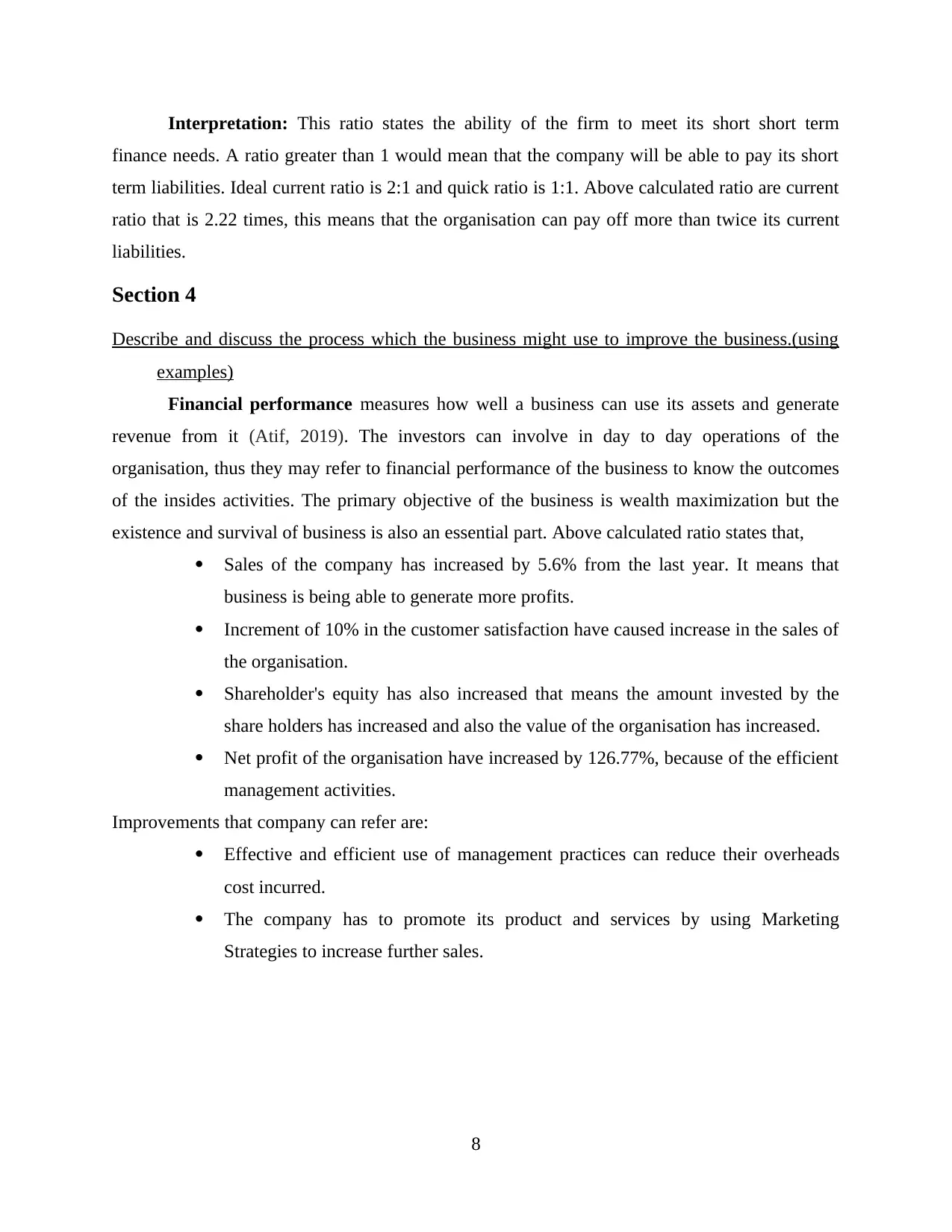
Interpretation: This ratio states the ability of the firm to meet its short short term
finance needs. A ratio greater than 1 would mean that the company will be able to pay its short
term liabilities. Ideal current ratio is 2:1 and quick ratio is 1:1. Above calculated ratio are current
ratio that is 2.22 times, this means that the organisation can pay off more than twice its current
liabilities.
Section 4
Describe and discuss the process which the business might use to improve the business.(using
examples)
Financial performance measures how well a business can use its assets and generate
revenue from it (Atif, 2019). The investors can involve in day to day operations of the
organisation, thus they may refer to financial performance of the business to know the outcomes
of the insides activities. The primary objective of the business is wealth maximization but the
existence and survival of business is also an essential part. Above calculated ratio states that,
Sales of the company has increased by 5.6% from the last year. It means that
business is being able to generate more profits.
Increment of 10% in the customer satisfaction have caused increase in the sales of
the organisation.
Shareholder's equity has also increased that means the amount invested by the
share holders has increased and also the value of the organisation has increased.
Net profit of the organisation have increased by 126.77%, because of the efficient
management activities.
Improvements that company can refer are:
Effective and efficient use of management practices can reduce their overheads
cost incurred.
The company has to promote its product and services by using Marketing
Strategies to increase further sales.
8
finance needs. A ratio greater than 1 would mean that the company will be able to pay its short
term liabilities. Ideal current ratio is 2:1 and quick ratio is 1:1. Above calculated ratio are current
ratio that is 2.22 times, this means that the organisation can pay off more than twice its current
liabilities.
Section 4
Describe and discuss the process which the business might use to improve the business.(using
examples)
Financial performance measures how well a business can use its assets and generate
revenue from it (Atif, 2019). The investors can involve in day to day operations of the
organisation, thus they may refer to financial performance of the business to know the outcomes
of the insides activities. The primary objective of the business is wealth maximization but the
existence and survival of business is also an essential part. Above calculated ratio states that,
Sales of the company has increased by 5.6% from the last year. It means that
business is being able to generate more profits.
Increment of 10% in the customer satisfaction have caused increase in the sales of
the organisation.
Shareholder's equity has also increased that means the amount invested by the
share holders has increased and also the value of the organisation has increased.
Net profit of the organisation have increased by 126.77%, because of the efficient
management activities.
Improvements that company can refer are:
Effective and efficient use of management practices can reduce their overheads
cost incurred.
The company has to promote its product and services by using Marketing
Strategies to increase further sales.
8
⊘ This is a preview!⊘
Do you want full access?
Subscribe today to unlock all pages.

Trusted by 1+ million students worldwide
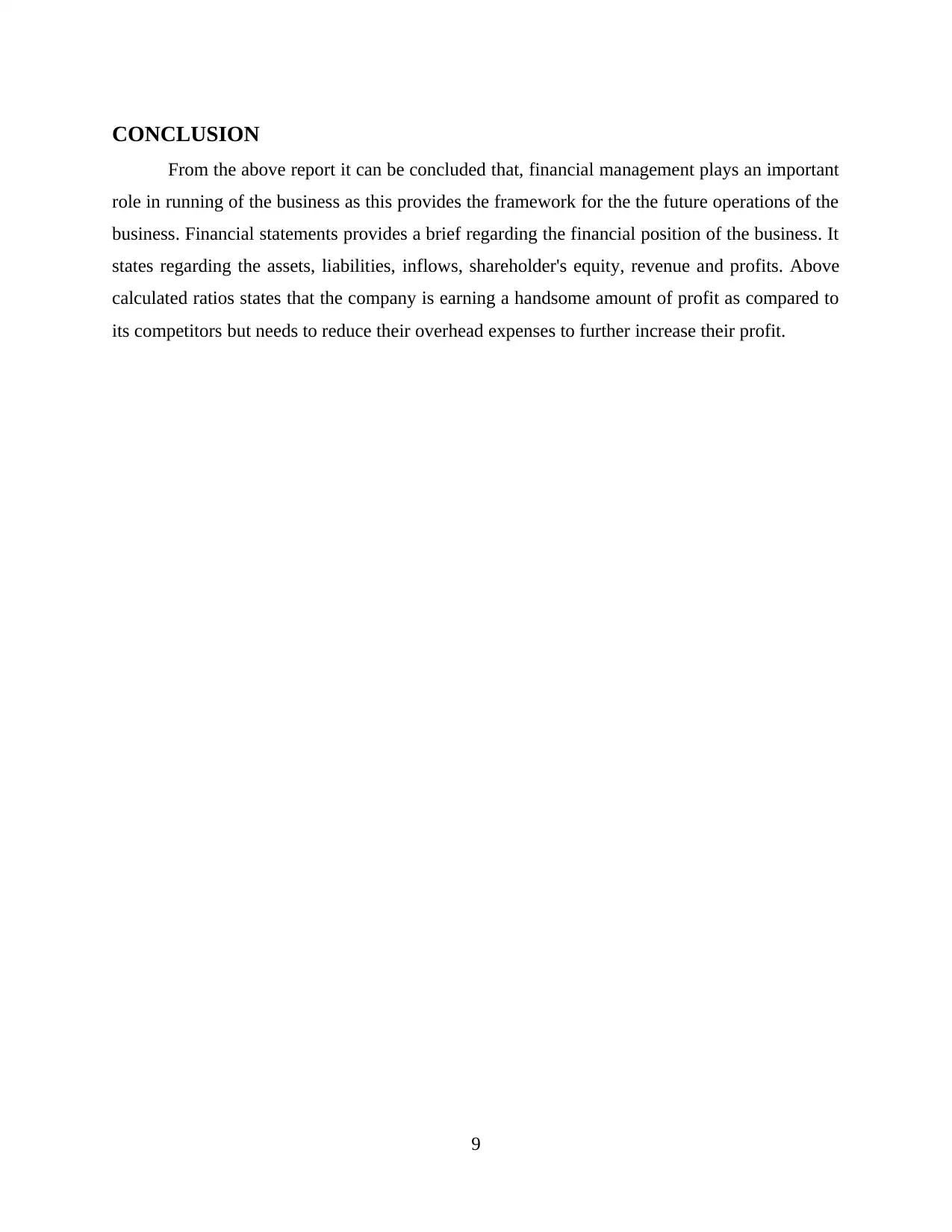
CONCLUSION
From the above report it can be concluded that, financial management plays an important
role in running of the business as this provides the framework for the the future operations of the
business. Financial statements provides a brief regarding the financial position of the business. It
states regarding the assets, liabilities, inflows, shareholder's equity, revenue and profits. Above
calculated ratios states that the company is earning a handsome amount of profit as compared to
its competitors but needs to reduce their overhead expenses to further increase their profit.
9
From the above report it can be concluded that, financial management plays an important
role in running of the business as this provides the framework for the the future operations of the
business. Financial statements provides a brief regarding the financial position of the business. It
states regarding the assets, liabilities, inflows, shareholder's equity, revenue and profits. Above
calculated ratios states that the company is earning a handsome amount of profit as compared to
its competitors but needs to reduce their overhead expenses to further increase their profit.
9
Paraphrase This Document
Need a fresh take? Get an instant paraphrase of this document with our AI Paraphraser
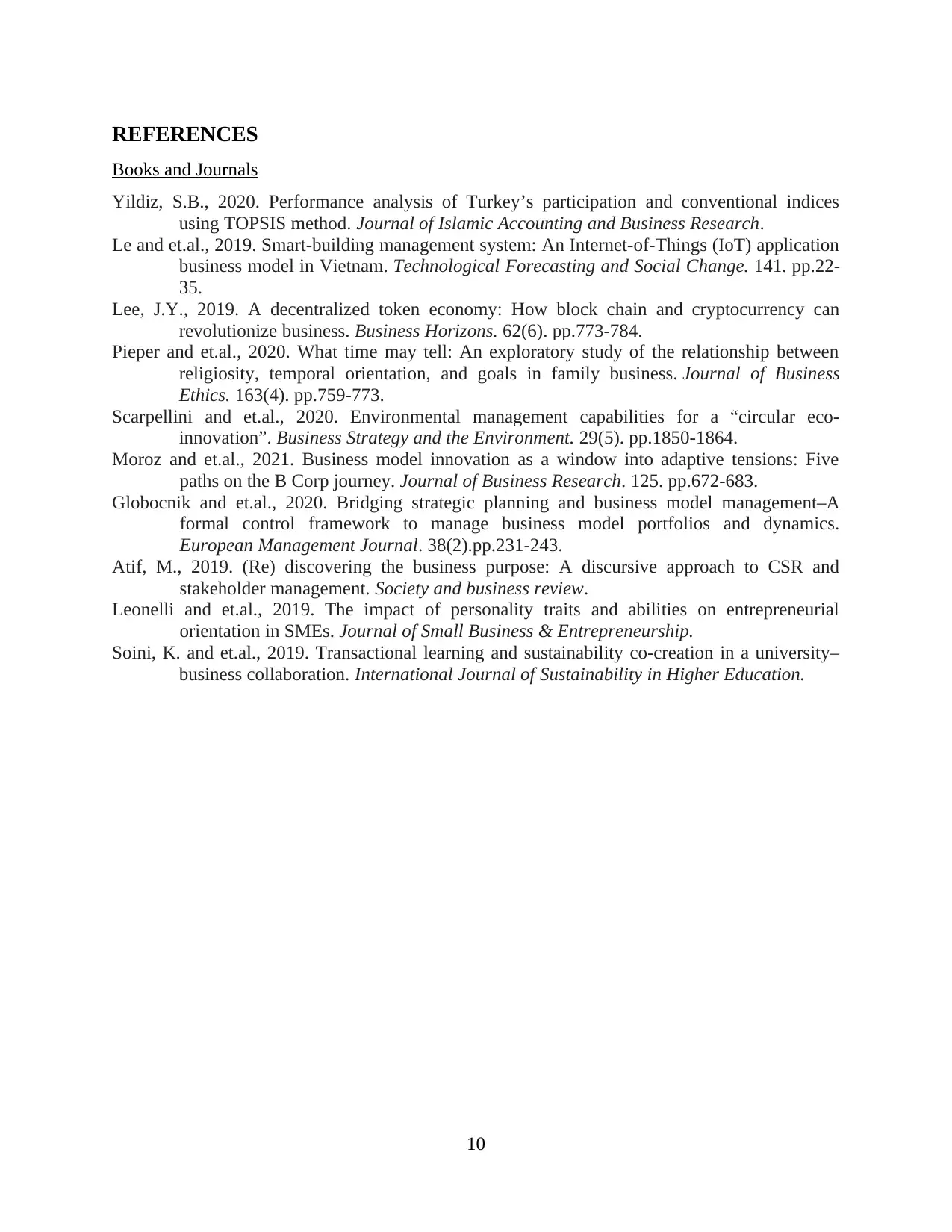
REFERENCES
Books and Journals
Yildiz, S.B., 2020. Performance analysis of Turkey’s participation and conventional indices
using TOPSIS method. Journal of Islamic Accounting and Business Research.
Le and et.al., 2019. Smart-building management system: An Internet-of-Things (IoT) application
business model in Vietnam. Technological Forecasting and Social Change. 141. pp.22-
35.
Lee, J.Y., 2019. A decentralized token economy: How block chain and cryptocurrency can
revolutionize business. Business Horizons. 62(6). pp.773-784.
Pieper and et.al., 2020. What time may tell: An exploratory study of the relationship between
religiosity, temporal orientation, and goals in family business. Journal of Business
Ethics. 163(4). pp.759-773.
Scarpellini and et.al., 2020. Environmental management capabilities for a “circular eco‐
innovation”. Business Strategy and the Environment. 29(5). pp.1850-1864.
Moroz and et.al., 2021. Business model innovation as a window into adaptive tensions: Five
paths on the B Corp journey. Journal of Business Research. 125. pp.672-683.
Globocnik and et.al., 2020. Bridging strategic planning and business model management–A
formal control framework to manage business model portfolios and dynamics.
European Management Journal. 38(2).pp.231-243.
Atif, M., 2019. (Re) discovering the business purpose: A discursive approach to CSR and
stakeholder management. Society and business review.
Leonelli and et.al., 2019. The impact of personality traits and abilities on entrepreneurial
orientation in SMEs. Journal of Small Business & Entrepreneurship.
Soini, K. and et.al., 2019. Transactional learning and sustainability co-creation in a university–
business collaboration. International Journal of Sustainability in Higher Education.
10
Books and Journals
Yildiz, S.B., 2020. Performance analysis of Turkey’s participation and conventional indices
using TOPSIS method. Journal of Islamic Accounting and Business Research.
Le and et.al., 2019. Smart-building management system: An Internet-of-Things (IoT) application
business model in Vietnam. Technological Forecasting and Social Change. 141. pp.22-
35.
Lee, J.Y., 2019. A decentralized token economy: How block chain and cryptocurrency can
revolutionize business. Business Horizons. 62(6). pp.773-784.
Pieper and et.al., 2020. What time may tell: An exploratory study of the relationship between
religiosity, temporal orientation, and goals in family business. Journal of Business
Ethics. 163(4). pp.759-773.
Scarpellini and et.al., 2020. Environmental management capabilities for a “circular eco‐
innovation”. Business Strategy and the Environment. 29(5). pp.1850-1864.
Moroz and et.al., 2021. Business model innovation as a window into adaptive tensions: Five
paths on the B Corp journey. Journal of Business Research. 125. pp.672-683.
Globocnik and et.al., 2020. Bridging strategic planning and business model management–A
formal control framework to manage business model portfolios and dynamics.
European Management Journal. 38(2).pp.231-243.
Atif, M., 2019. (Re) discovering the business purpose: A discursive approach to CSR and
stakeholder management. Society and business review.
Leonelli and et.al., 2019. The impact of personality traits and abilities on entrepreneurial
orientation in SMEs. Journal of Small Business & Entrepreneurship.
Soini, K. and et.al., 2019. Transactional learning and sustainability co-creation in a university–
business collaboration. International Journal of Sustainability in Higher Education.
10
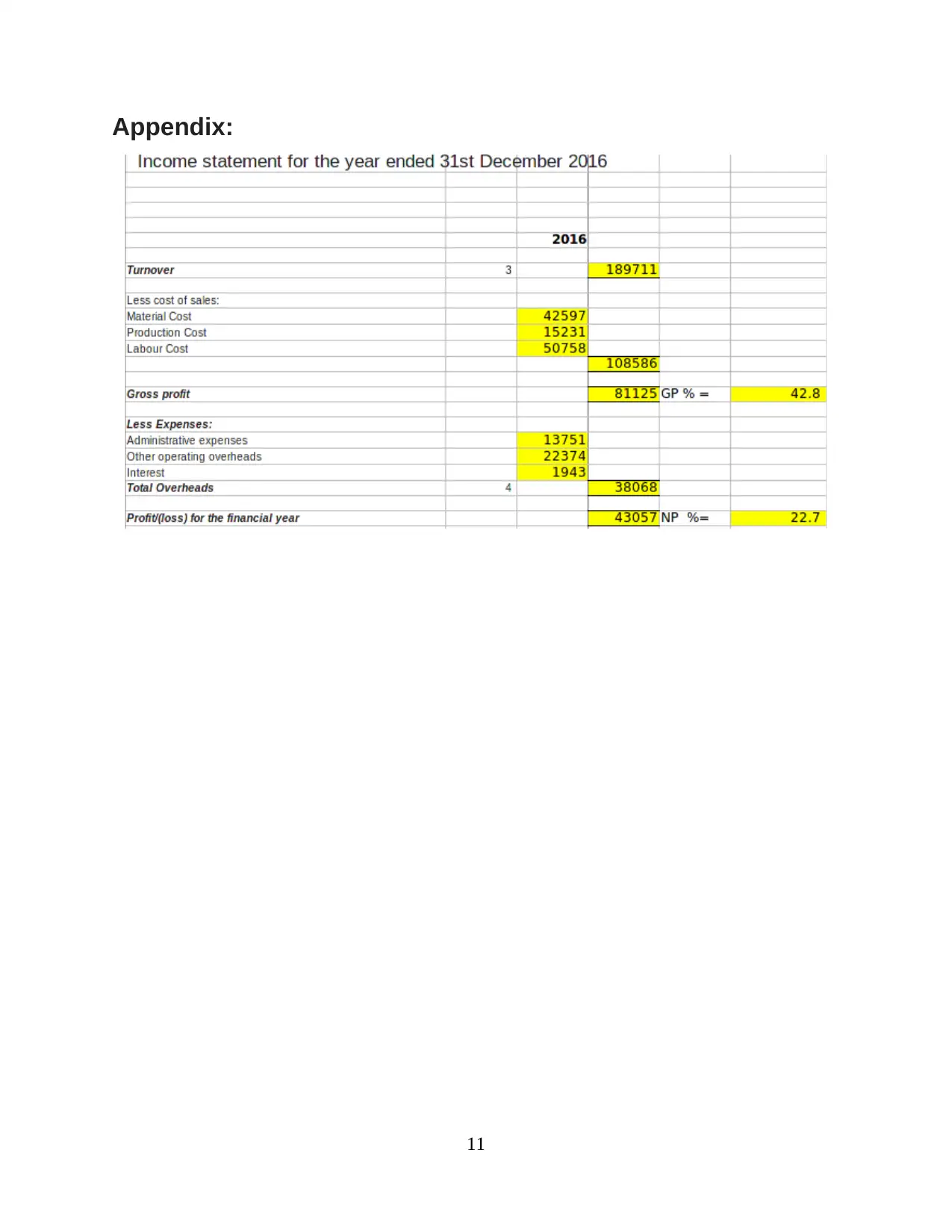
Appendix:
11
11
⊘ This is a preview!⊘
Do you want full access?
Subscribe today to unlock all pages.

Trusted by 1+ million students worldwide
1 out of 12
Related Documents
Your All-in-One AI-Powered Toolkit for Academic Success.
+13062052269
info@desklib.com
Available 24*7 on WhatsApp / Email
![[object Object]](/_next/static/media/star-bottom.7253800d.svg)
Unlock your academic potential
Copyright © 2020–2025 A2Z Services. All Rights Reserved. Developed and managed by ZUCOL.



